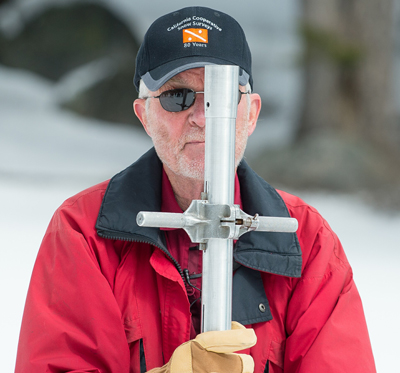April 2016 Snow Survey from California DWR on Vimeo.
Sierra Nevada Snowpack Grew During First Half of March, But Dry Spell Leaves Water Content Still below AverageMarch 31, 2016 - SACRAMENTO – California’s statewide snowpack usually reaches its peak depth and water content each year around the first of April, after which the snow begins to melt as the sun’s path across the sky moves a little further north each day. Therefore, conditions yesterday were just about as good as they’re going to get this year when the Department of Water Resources (DWR) conducted its media-oriented snow survey at Phillips Station in the Sierra Nevada east of Sacramento.
 (Left) Measuring snow depth. DWR Photography-Kelly Grow
(Left) Measuring snow depth. DWR Photography-Kelly GrowThe same is true for the statewide snowpack, which some had expected to benefit more than it has from El Niño conditions.Statewide, water content of the mountain snowpack today is only 87 percent of the March 30 historical average.
Frank Gehrke, chief of the California Cooperative Snow Surveys Program, and his survey team measured snow that was 58.4 inches deep at Phillips with a water content of 26 inches, just 97 percent of the long-term average there. The Phillips conditions for this time of year are dramatically improved compared to 2015’s zero depth and zero water content on April 1. Governor Edmund G. Brown Jr. stood on bare ground that day when he mandated a 25-percent reduction in water use throughout California.
The statewide readings also are much better compared to last year, when the water content of the snowpack was only five percent of normal, the lowest dating back to 1950. Today, the statewide snowpack’s water content is 24.4 inches, 87 percent of average.
Gehrke’s message to the media today was essentially the same one he delivered four weeks ago at Phillips: “While for many parts of the state there will be both significant gains in both reservoir storage and stream flow, the effects of previous dry years will remain for now.”
Electronic readings of northern Sierra Nevada snow conditions found 28.1 inches of water content (97 percent of average for March 30), 25.2 inches in the central region (88 percent of average) and 19.3 inches in the southern region (72 percent of average).
In normal years, the snowpack supplies about 30 percent of California’s water needs as it melts in the spring and early summer. The greater the snowpack water content, the greater the likelihood California’s reservoirs will receive ample runoff as the snowpack melts to meet the state’s water demand in the summer and fall.
Results of today’s manual readings by DWR near Echo Summit are as follows:

Electronic snowpack readings can be found at: http://cdec.water.ca.gov/cdecapp/snowapp/sweq.action
For earlier readings, click the calendar icon below the map, select a date, then Refresh Data.
Detailed information on major reservoir storage is found here:http://cdec.water.ca.gov/cdecapp/resapp/getResGraphsMain.action
Water Year 2016 precipitation is found at: http://cdec.water.ca.gov/snow_rain.html Look in the right-hand column for the Northern Sierra 8-station index for updated rainfall readings in the critical northern portion of the state, as well as the San Joaquin 5-station and Tulare Basin 6-station links.
Source: DWR









